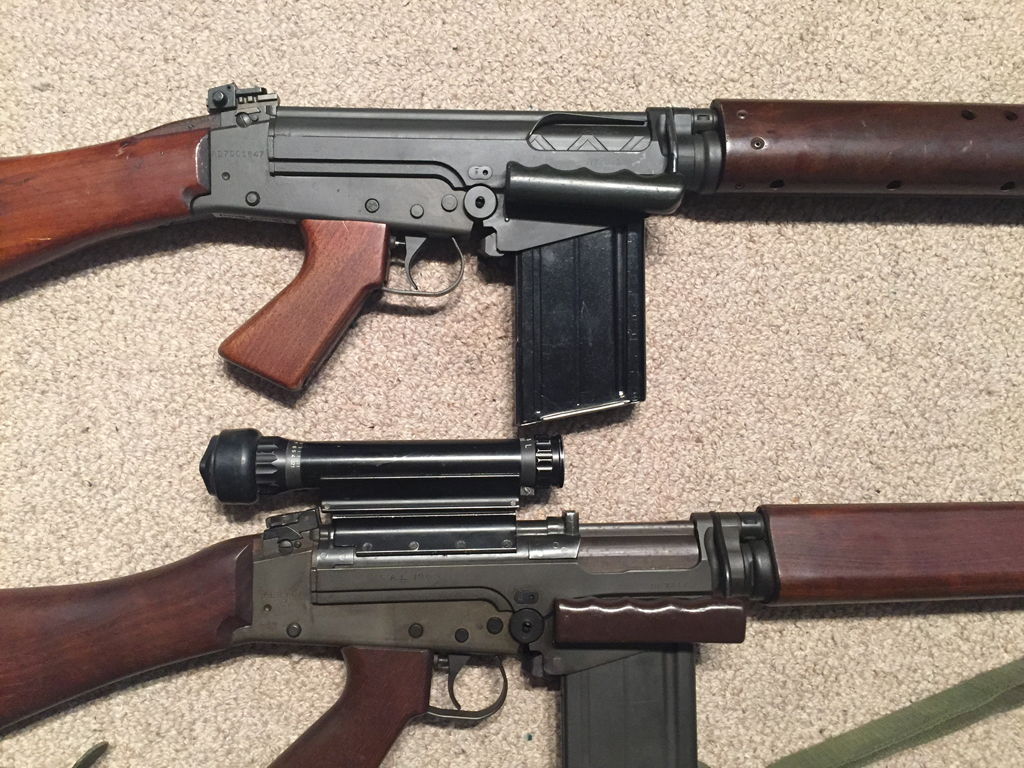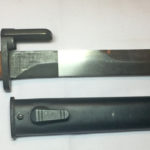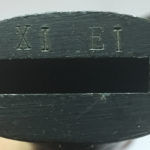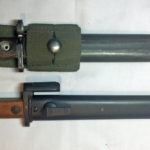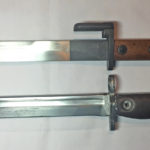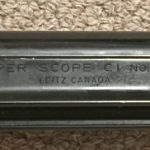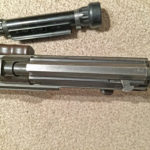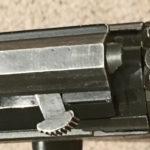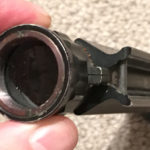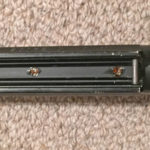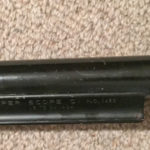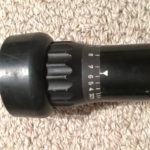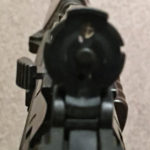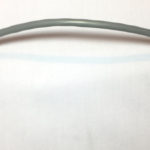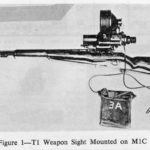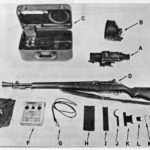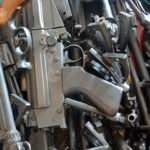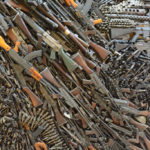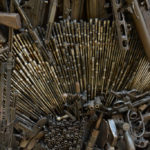
The Canadian Army, Royal Canadian Navy and Royal Canadian Air Force adopted the Belgian Fabrique National designed Fusil Automatique Leger (FAL), French for Light Automatic Rifle. These were made in the late 1950s and in the 1960s.
The Trials rifles EX1 and EX2 were made by FN in Belgium for Canadian Trails. The production rifles for Canada were made at Canadian Arsenals Limited (CAL), Long Branch, Toronto, Ontario, Canada. Canada was the first country to adopt the FN FAL type rifle which later became known as the “Right Arm of the Free World” due to the many countries that later selected and issued this type of rifle.
The Sniper Scope C1 could be easily fitted by anyone to any FN C1A1 rifle without any tools and there was no special sniper version of the FN C1A1 manufactured. At this time, in the late 1950s through the mid-1970s, the Militia (Reserve Army) had no sniper program and in the Regular Force it was minimal I believe. At the time, with the retirement of the Lee-Enfield No.4 MK.I* (T) .303″ sniper rifles, the FN C1A1 was the only sniper rifle on issue to the Canadian military. As far as I know, this sniper rifle model was only issued to the Regular Forces, not to the Militia.
It is important to remember that it was indeed a designated “sniper rifle” and that “Designated Marksman” is a more recent term and classification and is therefore not retroactively applicable.
HOW MANY FNs WERE MADE FOR OR BY CANADA?
It appears that fewer than 90,000 FN C1/C1A1 rifles were manufactured as the serial numbers only reach into the 8Lxxxx serial. None of those were especially built as sniper rifles, but any of these FNs could be fitted with a Sniper Scope C1.
Only 305 (Ref: Without Warning p. 71) SNIPER SCOPES C1 were ordered by Canada, so these are rare, thus making it about as rare as the 350 WWII Lyman Alaskan No. 32 TP MK.I and some of the R.E.L. C No. 32 scopes, but the C1 is less valuable as they are much newer and the rifles for the scope are “Prohibited” in Canada. Most of these rifles were destroyed. The author has recorded serial numbers of Sniper Scopes C1 from 1201 to 1561 which is a spread of 360, so it appears that more than the 305 listed bought by the Canadian Army were made, possibly for Australian and British testing.
These sniper scopes could be fitted onto any of these FN rifles without modification in about 15 seconds. All one had to do was break open the rifle, remove the body cover, insert the sniper body cover (with its Mount, Telescope, C2), close the rifle, and then pop the scope on. The scope is installed by pushing forward on the lever that is on the left side of the mount (see photos), hooking the scope on the front end of the scope mount, lowering the rear end of the scope and then releasing the lever. The removal was the opposite action. i.e. Push forward on the latch and and lift off the scope. The sniper body cover (Mount, Telescope, C2) could be left in place and the rifle could be used in the normal fashion or the body cover could be changed back. The “Cover Assembly, Adaptor” could be fitted onto the “Mount, Telescope, C2” (action cover with scope base fitted) to protect it from damage. As a result ANY FN C1A1 rifle with a Sniper Scope C1 fitted becomes a “sniper rifle”. These rifles and scopes were not mated and numbered to ensure that they remained together, as was and still is, usually the case with sniper rifles. If an FN C1A1 rifle is found with a C1 scope on it, that does not mean that the scope was on that rifle in service, but it does mean that it is now a legitimate sniper rifle.
CANADIAN FN RIFLE MODELS
Canada did not export these rifles to foreign markets.
- EX-1 – 1,500 were made by FN in Belgium for Canada. The EX-1 and EX-2 rifles were “Trials” rifles being tested to see if Canada would adopt the FN and also to see what improvements might be suggested before mass production began. Many of the EX rifles were later made into Drill Purpose rifles for cadets.
- EX-2 – 500 were made by FN in Belgium for Canada. These have a small optical sight.
- FN C1, FN C1A1 & FN C1A1D –
- R. Blake Stevens says that 72,775 C1/C1A1 were contracted to be purchased by DND. (ref. p. 83 NORTH AMERICAN FALs). Another figure is presented by Clive Law who stated that Canada ordered 72,470 (ref: Without Warning p. 71). The FN C1 rifles were later converted to FN C1A1 configuration which basically involved a new firing pin and a plastic carrying handle. The FN C1 and FN C1A1 were semi-automatic rifles and were carried by generations of Canadian soldiers, including myself. The official model designations in the EME manuals included brackets around the (C1) or (C2) e.g. FN (C1) A1, however the markings on the firearms did not use the brackets and in the Canadian military, we did not use the brackets either. We just used “FN”, “FN C1A1” or “C1A1” so that is the format that I am using on this page. Canada was reportedly the first country in NATO (North Atlantic Treaty Organization) to adopt the FN-FAL type rifle.
- Royal Canadian Navy (RCN) – Of these C1/C1A1 rifles above, 8,242 were manufactured as C1A1D with a selector lever, for the Royal Canadian Navy and are out of the large DND contract above. (ref. p.83 “North American FALs NATO’s Search for a Standard Rifle” by R. Blake Stevens) Presumably the RCN wanted the full-automatic capability for shore parties and boarding parties where they would only be in battle for short periods of time and thus overheating of the barrel was not a big concern. Reportedly the Royal Canadian Navy felt that the FN C2 was too heavy for their purposes. I did my basic training on board HMCS Gatineau in the Navy using the FN C1A1D (presumably this was the version) and Sten Mk. II in 1969.
- Royal Canadian Air Force (RCAF) – An unknown number were provided to the RCAF, presumably out of the above large DND contract. (ref. p.83 “North American FALs NATO’s Search for a Standard Rifle” by R. Blake Stevens)
- Royal Canadian Mounted Police (RCMP) obtained 493 FN C1A1, all in the 7Lxxxx serial number range (i.e. 70,000 range) according to “Arms & Accoutrements of the Mounted Police.” . I suspect that these were built after the contract was completed for the military. 100 in 1961 and by 1969 they had 493. but the matter is confusing as these serial numbers (ref. p. 194 of “Arms & Accoutrements of the Mounted Police 1873-1973”.) This is alleged to be all of the RCMP rifle serial numbers but it seems to be only 400 out of the reported 493. Low SN 7L0172 and high SN 7L1507 with many sequential serial numbers, but not all. It is a puzzle as the RCMP reportedly obtained their rifles between 1961 and 1969, yet all serial numbers are in the 7Lxxxx range. The RCMP’s FN rifles were stamped by RCMP armourers with the “MP” monogram on the receiver ring. A photo of this marking is on page 53 of “Arms and Accoutrements of the Mounted Police 1873-1973.”
- Ontario Provincial Police (OPP) obtained an unknown number of FN C1A1 rifles. They were stamped “OPP” on the lower right side just in front of the butt. They had 2 rifles per detachment and had at least 300 FN C1A1 rifles. Their rifles appear to all fall in the 8Lxxxx (i.e. 80,000)range of serial numbers.
- Dominion of Canada Rifle Association (DCRA) Members legally purchased an unknown quantity back when it was legal to do so. “NavyShooter” (on milnet.ca forums ) estimated about 300.
- Foreign Study Examples – A few examples were sent to other countries for study, test and reference study purposes e.g. to the Pattern Room in the UK, USA and likely Australia.
- SOME CANADIAN ACCESSORIES
- Sniper Scopes C1 could be mounted on any rifle. There were no permanent alterations made to the rifles designated as sniper rifles.
- Bayonet – For the EX1 and EX2 rifles, the bayonet was a Belgian made X2 E1 with scabbard X1 E1. The Canadian version has the rifle serial number on the pommel. The British version has the serial number on the underside of the grip. The Bayonet for the production rifles was the C1 bayonet which did not have a serial number.
- Blank Firing Attachment (BFA) –
- Grenade Launcher L2A1 – Spigot type.
- Magazine Charger –
- Section Cleaning Kit –
- Rubber muzzle cover –
- FN C2 and C2A1
- R. Blake Stevens wrote that the Canadian Department of National Defence contracted to buy 2,713 of these. (p. 83 NORTH AMERICAN FALs) The FN C2 and FN C2A1 was the Light Machine Gun version. The FN C2 and C2A1 had a heavier barrel, bipod that folded up to form a hand-guard, a larger rear sight and a selector switch with a full-automatic option. Normal issue of the FN C2A1 was one per infantry section. These replaced the Bren Gun in Canadian service.
- R. Blake Stevens says that 72,775 C1/C1A1 were contracted to be purchased by DND. (ref. p. 83 NORTH AMERICAN FALs). Another figure is presented by Clive Law who stated that Canada ordered 72,470 (ref: Without Warning p. 71). The FN C1 rifles were later converted to FN C1A1 configuration which basically involved a new firing pin and a plastic carrying handle. The FN C1 and FN C1A1 were semi-automatic rifles and were carried by generations of Canadian soldiers, including myself. The official model designations in the EME manuals included brackets around the (C1) or (C2) e.g. FN (C1) A1, however the markings on the firearms did not use the brackets and in the Canadian military, we did not use the brackets either. We just used “FN”, “FN C1A1” or “C1A1” so that is the format that I am using on this page. Canada was reportedly the first country in NATO (North Atlantic Treaty Organization) to adopt the FN-FAL type rifle.
Photos of Bayonets
THE FN C1A1 SNIPER RIFLE WITH SNIPER SCOPE C1

C1A1 rifle with Sniper Scope C1 – Left side.
The FN C1A1 Sniper Rifle, serial number 8L3317, used in these illustrations is DEACTIVATED and is in my collection. It is one of those rifles purchased by the Ontario Provincial Police (OPP), sold surplus to England and then brought back to Canada.
SNIPER SCOPE C1

The “SNIPER SCOPE C1” was made by Leitz and was their model ELC1088. The German company “Leica” built a new plant in Midland, Ontario. The reticle is a vertical tapered post in the lower half, with a dashed line across in the middle. The scope is provided with clicks of 1/2 mil. The range adjustment is by rotating the eye piece ring. The drum is graduated 1,000 yards scope in 100-yard increments. An additional adjustment of 3 mils (6 clicks) is provided at each end of the zeroing scale to allow for zeroing. (p. 122 North American FALs by R. Blake Stevens) Scope is about 4×28 and with 5 degrees left/right adjustment.
In 1959 Canada ordered 305 “C1 SNIPER SCOPE” sets on the same contract (CD544900) as the 72,470 rifles. Some were tested by Australia and the United Kingdom which likely explains why the serial numbers exceed 305 and may go as high as 360 or more. Those bought by Canada, and apparently those bought by Australia and the UK, were marked on the left side of the upper scope mount: “SNIPER SCOPE C1 No. xxxx / LEITZ CANADA” The xxxx was the serial number e.g. 1453 as in the example shown on this page.
Colonel Bingham reported that during testing, it was found that the FN C1 was more accurate than the No. 4 MK. I* rifle, partly due to the ammunition and due to the quality of the barrels made by Canadian Arsenals Limited. (p.107 North American FALS by R. Blake Stevens )
The Sniper Scope C1 kit consisted of:
- Telescope, Sniper C1.
- Cap Assembly, Telescope Lens ( Lens caps, see-through, joined by a single cord).
- Case, C1 Sniper Telescope.
- Screwdriver, 4 inch lg. 1/8 inch blade.
- Cloth, Cleaning, Lens.
- Mount Telescope C2 (this was the body cover with the base of the scope permanently attached. It could be swapped out with a regular body cover.)
- Cover, Assembly, Adaptor (To cover the scope base on body cover when scope was not attached.)
Canada wanted the soldiers to be able to be able to reload their rifles using 5-round stripper clips and the body cover was thus a short one, with a fitting on the front end, clear of the scope, to engage the stripper clip. The Sniper Scope C1 had a permanent scope base fitted to the body cover and the scope was short enough to clear the stripper clip guide. During trials they had experimented with a full length cover for the sniper scope, modified to take stripper clips.
EXTRACTS ON SNIPER SCOPE C1 FROM OBSOLETE ORIGINAL EME INSTRUCTIONS

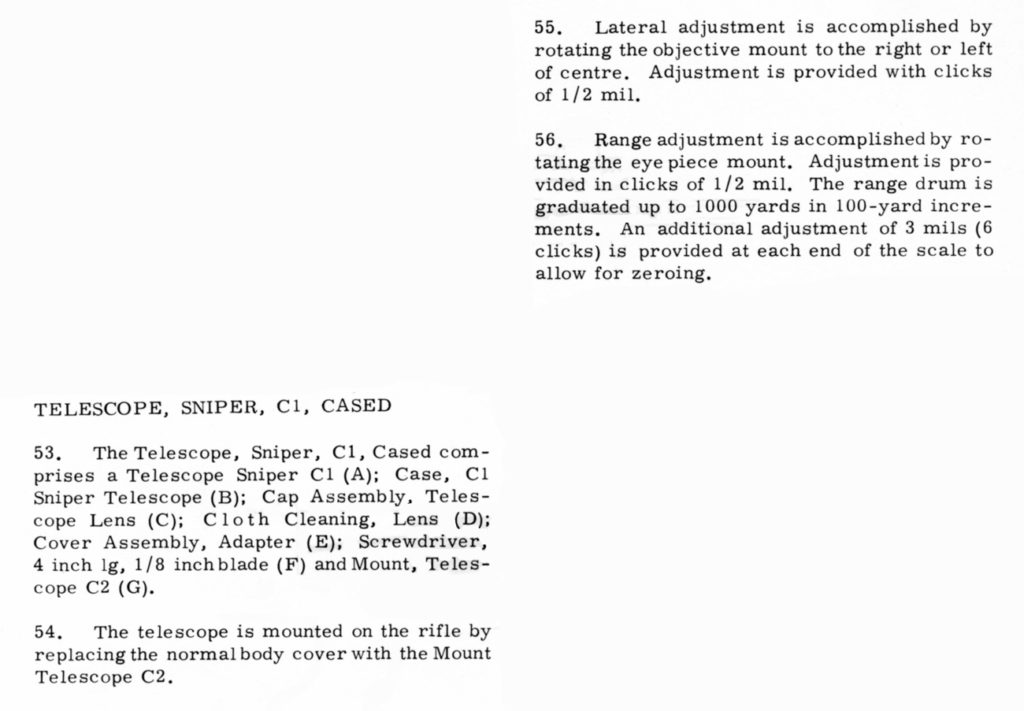

US T1 WEAPON SIGHT (Infra-red)
The Canadian military purchased some U.S. made infra-red T1 Weapon Sights also known as the AN/PAS-4. These were originally used on the M1C Garand sniper rifle and Canada fitted them onto the FN C2A1 and C1A1. (Reference “Without Warning” page 66).
They provided short-range night time vision of a few hundred yards but I have not come across any reports of them being issued as sniper rifles. I would be interested to hear if they were considered a sniper scope.
I was issued with one of these infra-red T1 (AN/PAS-4) sights mounted on an FN C2A1 just before a night exercise in the early 1970s while on an officer’s training course. I received no training on how to operate it. Unable to get it to focus, I removed the red filter. That night my team ambushed (on exercise, using blanks) a convoy of M113 Armoured Personnel Carriers. I turned on the light which acted as a bright white searchlight, and shone it into the eyes of the drivers and commanders of those vehicles, thus blinding them temporarily. The human eye takes about 1/2 hour to recover its night vision after exposure to a white light. Was this a “bright” action on my part? Although I quickly shone it at each APC’s driver and commander, and then quickly turned it off as I recall, many soldiers would point out that I made myself a target as the source of the light. We have all seen the war movies where they shoot out the searchlights.
The PAS-4 (i.e. the VARO Model 9903 or the POLAN made version) sights may be found occasionally for sale. The value is very low as the batteries were proprietary and there are so many new and improved night vision scopes available. There were a variety of mounts available as some were fitted to M-14 rifles and some to FN C2A1/C1A1 rifles.
COLLECTOR INTEREST
The only collector interest is as a display example. In Canada, FN C2A1 and C1A1 rifles are “Prohibited” so either a legal owner of a live one cannot take it out to shoot, or the owner of a deactivated one cannot open the action to change the body cover. A PAS-4 set sold at Poulin’s Auction 2014-06-10 (06/10/2014 ) LOT 4843A for USD $175.50.
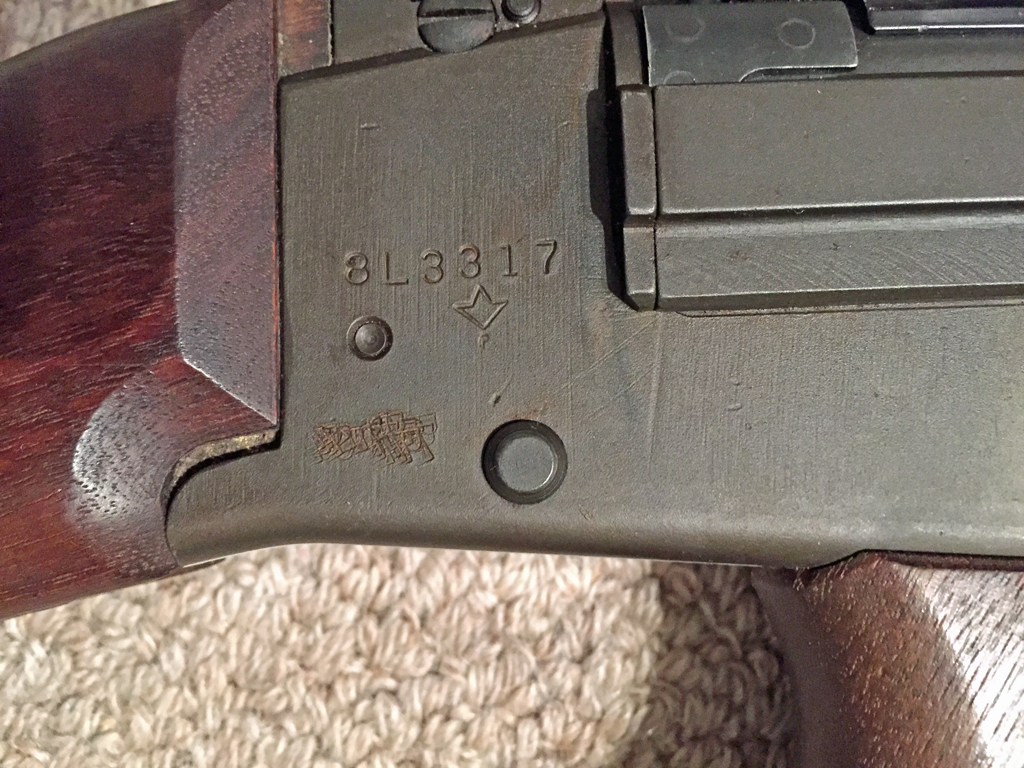
THE FN C1A1 SNIPER RIFLE IN USE
Mention of these sniper rifles in service is minimal which is not surprising as Canada was not at war during this time period of their use. The Sniper Scope C1 would fit on any Canadian FN so there were no specialized sniper rifles at that time. As far as I know, the Sniper Scopes C1 were only issued to the Regular Forces. In Canada it was “politically incorrect” for the Reserves to be issued sniper weapons which are intended only to kill, though one cannot help but wonder why the reserves are issued any weapons at all in that case. Canada was involved in United Nations peacekeeping. One FN C1A1 sniper rifle was reported to have been seen in Cyprus with Canada’s United nations Forces in Cyprus (UNFICYP) Detachment. Another such sniper rifle was seen in a display at Connaught Ranges near Ottawa. Some sniper scopes and mounts were found in a box in a basement (apparently at a military facility) but were not issued.
I was told the following story by the fellow sitting next to me in the movie theatre in Richmond, BC during a screening of “American Sniper” He stated that he was in charge of the sniper team (presumably of 3PPCLI) at Workpoint Barracks near Victoria, B.C. During an inventory they had discovered a batch of crated No. 4 MK. I* (T) sniper rifles in a bunker. The team was preparing to go to Wainwright, Alberta for a regimental sniper competition where three battalions were to compete. His team chose to use the old Lee-Enfields and won the competition. The other battalions complained, saying that the competition as for issued service sniper rifles. He explained that these rifles were actually issued to his team!
I have only found the following two photos showing the FN C1A1 sniper rifle in service. Other stories and photos about these FN C1A1 sniper rifles are welcomed. I would be interested to hear of any other surviving examples.
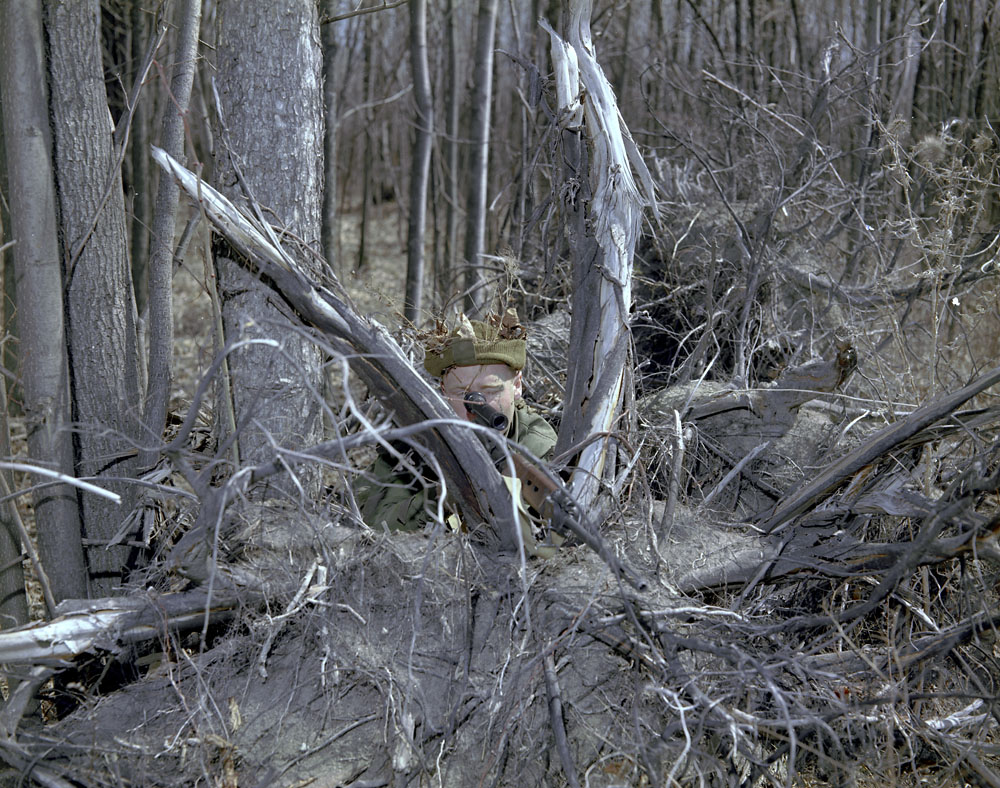

WHAT HAPPENED TO ALL OF THE CANADIAN FN RIFLES?
The FN EX1 and EX2 rifles were converted to Drill Purpose (DP) rifles for use by cadets and as jump rifles with the paratroopers. I recall seeing some of these on issue to the Seaforth Cadets at the Seaforth Armoury in the early 1970s.
The FN rifles were replaced in Canadian military service by the C7 rifle, a derivative of the American Armalite Rifle M16A1, in the mid-1980s. The SNIPER SCOPES C1 were withdrawn from the Regular Forces in March 1976 and were held in reserve. Over time a number of them became unserviceable, were sold or were lost. In 1994, the last of the Sniper Scopes C1 were disposed of by releasing them to Cadets to use for sighting in rifles at Connaught Ranges near Ottawa. The mount appears to have been modified for this piurpose.
Canada apparently later destroyed the vast majority of her “War Reserve” stocks of the FN rifles and SMG C1.
- A few examples were kept for the Canadian War Museum and for military museums. The Canadian War Museum for example has an FN C1A1D selective fire rifle made for the Royal Canadian Navy (Accession number CWM 19780274-020). Rob Love of Shilo, Manitoba “was told by the Life Cycle manager of the FNs that he retained 300 of each of the old series weapons (C1A1, SMGC1 etc, but not the EX rifles) for research and museum purposes.” Some of the EX rifles were however saved. A Canadian Armed Forces official military museum that I started and ran for many years was promised examples of these and other obsolete weapons by the Department of National Defence, but the weapons vanished in the system and we never did get them. It is possible that a few were made into trophies for the Canadian Armed Forces but I have no confirmation on this.. Several dozen deactivated examples were given to anti-gun artists to make an anti-gun sculpture. Some of these are shown in these photos though none are known to have been provided to collectors or nostalgic ex-military personnel.
- RCMP – The RCMP retained 4 rifles for museum displays and turned over the rest (489?) to the Canadian military. (ref. Arms & Accoutrements of the Mounted Police p. 53). A political comment. The RCMP used to have Lee-Enfield No. 4 MK. I* rifles and then had FN C1A1 rifles. They phased them out. Then there were several tragic shootings of RCMP members in Mayerthorpe, Alberta (2005-03-05) and then in Moncton, New Brunswick (2014-06-04). RCMP members were not armed with rifles and were outgunned in both cases. The RCMP have been issuing “Police Carbines” which is a politically correct term for “assault rifle”, which is what they would call the same firearm if a civilian legally owned it. NWMP and RNWMP were all issued with rifles as well as their handguns.
- OPP – In the early-mid 80’s, the Ontario Provincial Police FN C1A1 rifles were deemed surplus, and were gathered for disposal. Some (most or all?) were sold to a company in the U.K., hence the UK import and proof marks on the underside of the barrel just in front of the hand-guard. That company then sold approximately 300 of them to Commonwealth Militaria in Ontario. Commonwealth Militaria then sold them for between $750 and $1,400 per rifle (the prices went up over the years), Thus there are approximately 300 of these rifles in Canada plus a few DCRA rifles. re: NavyShooter on Milnet.ca Here is a link to his posting on that forum. I have been informed that the story is actually more complicated than this.
- DCRA & other private owners – A few FN C1 / C1A1 rifles had been purchased directly from Canadian Arsenals Limited by Dominion of Canada Rifle Association target shooters. Serial numbers 8L5006 to 8L5012 were among those sold in 1972 to private owners, back when these rifles were legally simply “rifles”. A rough estimate by Navy Shooter on milnet.ca was about 300.
- A few would have been sent to Allied nations for evaluation and as reference study examples e.g. The Pattern Room in the UK, USA and Australia.
- Canada did not export Canadian made FNs, whereas Australia did export some Australian made FNs e.g. to Singapore. FN C1A1 and family rifle outside of Canada are extremely rare.
- These FN rifles are now all out of service and are obsolete in Canada. As a result all of the technical information on them is now obsolete. I would estimate that over 98% of them were destroyed. “NavyShooter” estimated that about 1,100 Canadian made FN rifles have survived as of 2010. This would include both live and deactivated examples. Of these, only a small handful are equipped with the Sniper Scope C1. Thus an FN C1A1 rifle equipped with a Sniper Scope C1 is extremely rare, whether “live” or deactivated.
- Here is an external link to a YouTube video by gun business MARSTAR in Canada showing the live firing of an FN C1A1 Sniper rifle fitted with a Sniper Scope C1.
LEGAL STATUS OF THE FN RIFLES IN CANADA
In 1998, the Canadian Government declared all (live) variants of the FN FAL / C1A1 etc. to be PROHIBITED in Canada (item 74 on the list). This means that those who owned one or more in that category at the time the law changed and have continuously owned at least one in this category to the present, may continue to own, buy and sell within this class. These owners usually are not permitted to shoot them however. Once all of these grandfathered owners die, then no private citizen in Canada will be allowed to own a live FN FAL type of rifle. A number of these rifles that were in private ownership have been deactivated in order to sell them to other collectors, including the one shown in this web page. Once permanently deactivated, then they are no longer firearms and may be owned by anyone in Canada. The FN FAL family of rifles are legal in the USA and as a result a fair number of the surviving SNIPER SCOPE C1 have been purchased by Americans who can actually shoot and enjoy these rifles.

WHERE CAN I GET ONE?
Other than the fact that the rifle is extremely rare due to most of them having been destroyed and few having been released to the public, and the very limited number of Sniper Scope C1 that were made, just finding one for sale is a real challenge.
The scopes do turn up for sale, often with the case. The scopes are popular in the USA as they may be fitted to any FN FAL as I understand it. The hardest part to find is the “Mount, Telescope, C2” and there appear to be more scopes surviving than body covers with this Mount C2 installed. The scopes are old fashioned compared to modern scopes, but they are military issue sniper scopes which can be an important factor in some shooting matches.
The C1A1 rifles are quite legal in the USA, Italy, NZ, France etc. I believe, but as I understand the U.S. laws, Americans are not allowed to import them into the USA even if they found one for sale in Canada. A few deactivated examples are in collections in Canada. A number of owners in Canada hold live examples which are legally classed as “Prohibited” meaning only someone with that class of Firearms Licence may own them. Included in that category are some gun dealers (such as Marstar – see video link on this page) and movie supply companies. It is possible to purchase one of these if you do not have a Prohibited class licence, but if you do not have the correct Prohibited status on your licence, then you can only buy it if the rifle is PERMANENTLY deactivated and then removed from the RCMP gun registry.
REFERENCES:
- CANADIAN ARMY EME PAGES WEAPONS C820
- Issue 1 Date unknown
- Issue 2 – 19 Jan 62
- Issue 3 – 30 Mar 62
- CANADIAN ARMY EME PAGES WEAPONS C 822 RIFLE, 7.62 MM, FN (C1) A1 pp. 13 “Telescope, Sniper, C1, Cased” paragraphs 53 through 56.
- CANADIAN ARMY EME PAGES WEAPONS C 823 Inst. 1 page 21 “Telescope, Mount C2 and Adaptor Cover” Paragraphs 102-103. “Zeroing” Paragraphs 108-110
- Canadian Army Manual of Training CAMT 7-51 RIFLE, BAYONET AND AUTOMATIC RIFLE (PROVISIONAL) This manual does not seem to mention the sniper rifle version.
- INSTRUMENTS S630 – I have not seen this document, but as it is referred to in Canadian Army EME MANUAL WEAPONS C 820 immediately before the photos of the scope and its accessories, I presume that it refers to the SNIPER SCOPE C1 [I would like a copy of “INSTRUMENTS 630”, preferably an original.]
- “WITHOUT WARNING” by Clive M. Law. pp. 65-71 This is an excellent overview of Canadian sniper rifles. Available from http://www.servicepublications.com
- “ARMS & ACCOUTREMENTS OF THE MOUNTED POLICE 1873 – 1973” by Roger F. Phillips & Donald J. Klancher 1982 pp. 53 & 194
- “THE FAL RIFLE Deluxe Classic Edition” 1993 [or the earlier edition of 1/3 of that compilation entitled “NORTH AMERICAN FALs – NATO’s Search for a Standard Rifle” by R. Blake Stevens (1979)] This is the ultimate reference book on the FN FAL family of rifles.
